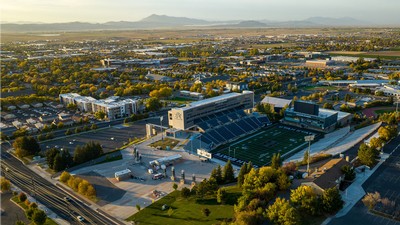In the background, 40,000 fans screaming, all eyes focused on two horses, War Admiral and Seabiscuit, running what would later be called the “Match of the Century.” Entering the last stretch of the race both horses are even, head and head until the final drive starts. At that moment, Seabiscuit’s jockey, George Woolf, turned to Charles Kurtsinger, the jockey atop War Admiral, and said “so long, Charlie,” as Seabiscuit pulled away.
That is the sensationalized scene as portrayed in the popular 2003 movie Seabiscuit.
While dramatized by Hollywood, the story of Seabiscuit and the race against War Admiral had a very real impact on America in 1938. Winning the race propelled Seabiscuit into national and international fame and crafted the legend used to create the movie.
With the success of the movie and eminence of the legend itself, it is hard to find someone who does not know the story of Seabiscuit. Less well known is a local thread connecting Cache Valley to Seabiscuit.
John Pollard, Seabiscuit’s regular jockey, was injured in a racing accident and was replaced with George Woolf. Already an accomplished racer, Woolf was most noted for riding Azucar to several victories, including the 1935 $100,000 Santa Anita purse, the first $100,000 prize in horse racing history. Despite his accomplishments, it was not until “Georgie,” as he was called, jockeyed Seabiscuit to victory over War Admiral that he gained national notoriety.
In many ways George Woolf was like the horses he was racing — bred for success — and his family line began in Cache Valley, Utah. George’s great grandfather, John Anthony Woolf II, first brought the Woolf name to Cache Valley in 1861. John Anthony and his family were among the first to breed “blooded” horses in Cache Valley. George’s grandfather, Absalom Woolf, came to Hyde Park with his father John Anthony and was a member of the Utah Militia fighting in the Walker Indian and Echo Canyon wars. Absalom was also known throughout Utah for the expense and care he gave to his horses, a trait that he carried to his experience as a Utah Minute Man. George Woolf’s parents, Frank Woolf and Rose Parker, were born and raised in Hyde Park, and it is said that Rose was a circus trick rider and Frank was a rodeo horse rider. The young couple moved to Alberta, Canada, where “Georgie” was born. Frank and Rose lived their adult lives in Canada, and Frank died in Calgary, Alberta, Canada.
While never living in Hyde Park or Cache Valley, George Woolf had many family members who remained in Cache Valley following his career with interest. A headline in the Journal newspaper trumpeted “Winning Jockey in Recent Big Santa Anita Race is Known in Cache Valley,” with a slightly smaller sub-head reading “George Woolf, Rider of Azucar, is Relative of Logan, Benson and Hyde Park families.”
Sadly, Georgie’s life ended short. He died in 1946 doing what he loved — while competing in a race, he fell from his horse, dying the next day. George’s place in racing history is clear, if not in the world famous restaurant he helped create, The Derby at Arcadia, then in the life-size bronze statue erected in his honor at Santa Anita Park. His memory continues to be honored today through the Santa Anita George Woolf Memorial Jockey Award. The award, according to a number of Web sites, has been given annually since 1950 to a North American jockey, chosen by his or her peers, who demonstrates high standards of personal and professional conduct both on and off the racetrack.
This lost connection between Seabiscuit and Cache Valley is among the many historical troves to be found in the newly available Ada Morrell Family Scrapbook Collection (call number P0355) at Utah State University’s Special Collections and Archives. The scrapbooks mostly contain Cache Valley history, and cover a time period from 1805 to 1980.
The creator of the scrapbook collection, Ada Eliza England Morrell, was born April 9, 1887 in Hyde Park, Utah, to Charles England and Phebe Almira Woolf England. Ada’s relationship to George is now difficult to trace, complicated by the dual family relationships brought about by the practice of plural marriage. George and Ada share a common grandfather, Absalon Woolf, but different grandmothers. As a result, George and Ada were half-cousins.
Ada Morrell lived most of her life in Cache Valley, graduating from Brigham Young College, and she was a lifelong member of the Logan Second Ward. Morrell was a local historian, noted for publishing “One Hundred Years of History of the L.D.S. Logan Second Ward, 1861 to 1961.” She served as a captain for the Daughters of the Utah Pioneers and was honored for her dedication in collecting and preserving Woolf Family documents. Ada Morrell passed away at the age of 90 December 5, 1977.
The Ada Morrell Family Scrapbook Collection
Brad Cole, associate dean for special collections and archives at Utah State University’s Merrill-Cazier Library, said there are numerous gems in the Morrell Scrapbooks, including a typed copy of the Madison Daniel Hambleton journal. The original is held by the Daughters of the Utah Pioneers but the typed copy is now available at Special Collections and Archives. The journal covers the whole of Hambleton’s life, from his conversion to Mormonism, the death of his brother from consumption in Indiana, dancing in the endowment room of the Nauvoo temple with Brigham Young and other apostles, to the hardships faced when settling the Deseret Territory. The Morrell Scrapbooks also provide the only known photograph of Hambleton.
Along with their historical significance, the Morrell Scrapbooks contain 694 pedigree charts, more than 130 obituaries, numerous historical documents and 1,439 photographs. The photographs include historic images of Logan, including an early 20th century image of the offices of the Journal Newspaper.
The
Ada Morrell Family Scrapbook Collection (P0355) is now available for public research. An inventory of the collection can be found
online, and all materials can be viewed at Special Collections and Archives in the Merrill-Cazier Library. Queries about the collection may be made by calling (435) 797-2663 or by emailing the department,
SCWEB@usu.edu. The scrapbooks were generously donated by Ada Morrell’s daughter-in-law, Edna Morrell, and Edna’s son, Reid Morrell.
USU’s Division of Special Collections and Archives collects, preserves and makes available the special collections materials of the Utah State University libraries for the use of students, faculty, scholars and the general public.
Special Collections welcomes donations of historically significant material about Cache Valley, the Intermountain West and the West. For information, contact the office, (435) 797-2663.
Related links:








